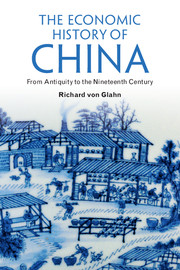Book contents
- Frontmatter
- Dedication
- Contents
- List of figures
- List of maps
- List of tables
- Acknowledgments
- Introduction
- 1 The Bronze Age economy (1045 to 707 BCE)
- 2 From city-state to autocratic monarchy (707 to 250 BCE)
- 3 Economic foundations of the universal empire (250 to 81 BCE)
- 4 Magnate society and the estate economy (81 BCE to 485 CE)
- 5 The Chinese-nomad synthesis and the reunification of the empire (485 to 755)
- 6 Economic transformation in the Tang-Song transition (755 to 1127)
- 7 The heyday of the Jiangnan economy (1127 to 1550)
- 8 The maturation of the market economy (1550 to 1800)
- 9 Domestic crises and global challenges: restructuring the imperial economy (1800 to 1900)
- Bibliography
- Index
8 - The maturation of the market economy (1550 to 1800)
Published online by Cambridge University Press: 05 March 2016
- Frontmatter
- Dedication
- Contents
- List of figures
- List of maps
- List of tables
- Acknowledgments
- Introduction
- 1 The Bronze Age economy (1045 to 707 BCE)
- 2 From city-state to autocratic monarchy (707 to 250 BCE)
- 3 Economic foundations of the universal empire (250 to 81 BCE)
- 4 Magnate society and the estate economy (81 BCE to 485 CE)
- 5 The Chinese-nomad synthesis and the reunification of the empire (485 to 755)
- 6 Economic transformation in the Tang-Song transition (755 to 1127)
- 7 The heyday of the Jiangnan economy (1127 to 1550)
- 8 The maturation of the market economy (1550 to 1800)
- 9 Domestic crises and global challenges: restructuring the imperial economy (1800 to 1900)
- Bibliography
- Index
Summary
Emperor Hongwu's project of social and economic reformation delivered a shocking blow to China's commerce and industry, especially in Jiangnan, the empire's economic heartland. The author of a Suzhou gazetteer published in 1506 acidly observed that Hongwu's campaigns against Suzhou's landowners, the forced removal of wealthy families to the capital, and the conscription of artisans into hereditary service to the state, had severely retarded the city's population growth and economic recovery even a century afterward. But by the end of the fifteenth century Hongwu's key institutional innovations – the lijia village household organization and the liangzhang tax headmen – were essentially defunct, and the system of hereditary occupational households inherited from the Yuan had atrophied as well. The ban on private maritime trade was still in force, although Fujian seafarers easily evaded the lax net of enforcement. By the early decades of the sixteenth century commercial growth was beginning to revive, despite lingering obstacles such as a stagnant money supply following the closure of the Ming mints in the 1430s.
Economic developments in the sixteenth century utterly erased Emperor Hongwu's vision of village autarky and self-sufficiency. Steady gains in agricultural production and the formation of national markets for industrial goods such as cotton, silk, and porcelain stimulated regional specialization. The growing allure of overseas trade following the abrupt influx of silver imports – first from Japan, and later from Spain's American colonies – beginning in the 1540s galvanized agitation against the interdiction of foreign trade, which was repealed in 1567. Massive infusions of foreign silver stoked the fires of commercial and industrial growth during the last century of the Ming, especially in coastal regions with ready access to foreign markets. The expansion of the money economy, the growth of rural industries, the increasing spatial range of markets, the greater volume of foreign trade, the disappearance of bound labor, and the ascendancy of private enterprise over state economic management all contributed to what some scholars have referred to as a “second economic revolution” (after the first “economic revolution” of the Tang-Song transition) beginning c. 1550.
Commercial revival in the late Ming
Hongwu's campaigns against the entrenched landowning elite of Jiangnan resulted in a leveling of rural society and more fragmented landholdings. Individual farms typically consisted of a number of plots spread over a wide area; the properties of large landowners often were scattered over several counties.
- Type
- Chapter
- Information
- The Economic History of ChinaFrom Antiquity to the Nineteenth Century, pp. 295 - 347Publisher: Cambridge University PressPrint publication year: 2016



